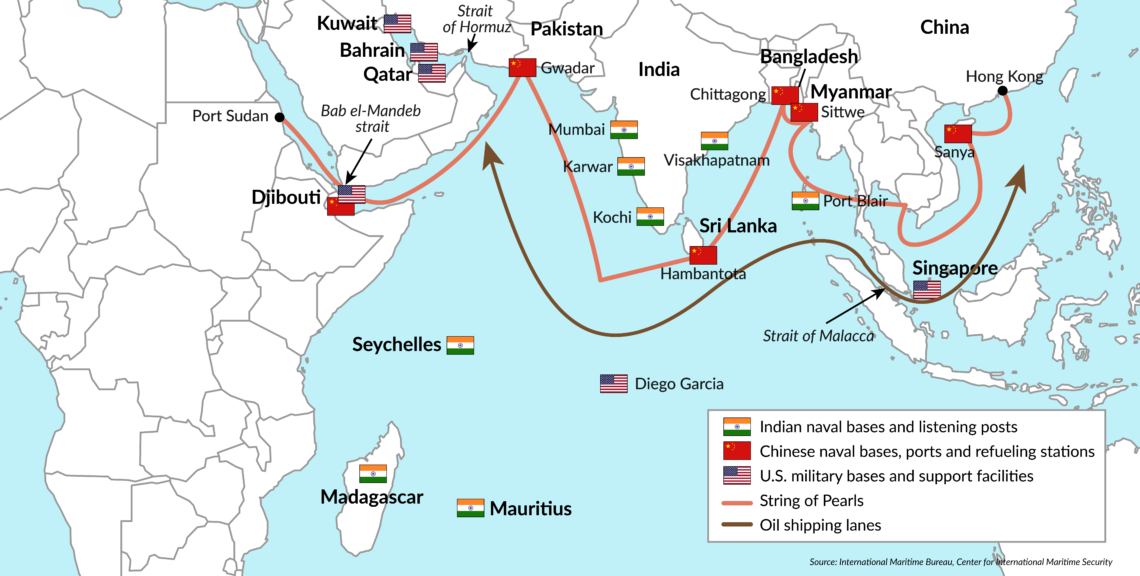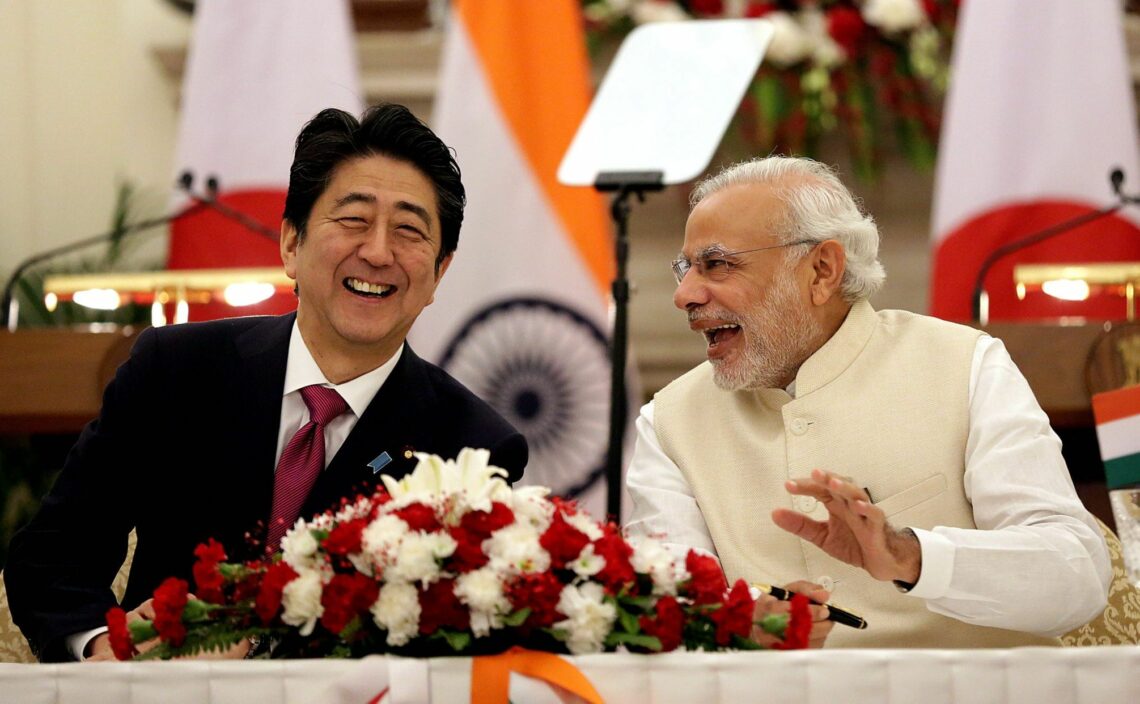The burgeoning India-Japan partnership
Japan and India are fast enhancing their partnership. Both countries want to counteract China’s rise, especially in the Indian Ocean. The countries have strengthened economic and military ties, and together could challenge China at the sea. As Beijing attempts to project its power ever further, the Indo-Japanese partnership will only grow.

In a nutshell
- Recently, the Indo-Japanese relationship has grown warmer
- The main reason is China’s rise and its projection of power into the Indian Ocean
- Stronger military ties between Tokyo and Delhi have alarmed Beijing
- The partnership seems destined to grow stronger, especially in naval matters
The enemy of my enemy is my friend. This ancient principle is gaining new relevance in a world of fast-shifting geopolitics. It is also at the heart of a new and unprecedented rapprochement between Japan and India.
China is competing with India for influence in Asia, and has hugely increased its diplomatic, economic and political involvement in Pakistan, India’s archrival. At the same time, China is also a historic adversary of Japan. So it is logical that at a time when China is projecting its power ever further, Tokyo and New Delhi have grown closer. In fact, it is surprising how long it has taken for the rapprochement to come about, though geographical and cultural distance have been factors. History, too, has not helped bring the two countries together.
Shadows of history
A major religion in Japan is Buddhism, which has its origins in India. Unlike the Chinese, the Japanese readily admit this fact. During World War II, Japan invaded the northeastern part of then British-controlled India. One of the leading protagonists of Indian independence was Subhas Chandra Bose, who favored cooperating with Imperial Japan to expel the hated British from the subcontinent. Bose’s Indian National Army refuted the position taken by Mohandas Gandhi and Jawaharlal Nehru, who had agreed to cooperate with the British colonial masters to defeat the Axis powers.
Since Prime Minister Modi came to power, India and Japan have fostered closer ties.
After independence in 1947, India pursued a protectionist, socialist economic policy, closing the country off and cooperating closely with the Soviet Union. Only in the early 1990s did India begin to modernize and open its economy. The first foreign car manufacturer allowed to enter the Indian market was Suzuki, which today, under the Maruti brand, still controls more than 40 percent of the Indian car market.
Change under Modi and Abe
It took quite some time for Japan Inc. to start seriously investing in India. Since Indian Prime Minister Narendra Modi came to power in 2014, the two countries have fostered closer ties. Previously, as chief minister of Gujarat, Mr. Modi had already encouraged Japanese companies to come to the western Indian state. In Japanese Prime Minister Shinzo Abe, he found a willing partner and a man interested in international and geopolitical affairs – a rarity among the usually short-tenured heads of Japanese government.
Mr. Abe is aware that American support for Japan has become more fragile since President Donald Trump entered the White House. At the same time, he has watched China’s reach grow more expansive. The Middle Kingdom’s rise had already been underway before Mr. Abe became Prime Minister. But Japanese concern has grown over the past 10 years and especially since President Xi Jinping came to power in 2012. Chinese military expansion in the South China Sea and in the Indian Ocean, as well as the loudly promoted Belt and Road Initiative (BRI), have rattled Tokyo. In response, it has intensified efforts to bolster its position in the immediate neighborhood, and also to increase its presence in Southeast Asia and South Asia.

The main tools Japan can use to head off China’s ambitions and expand its own influence are trade, finance and soft power. From Myanmar to Indonesia, India and Thailand, Asia has witnessed a substantial increase in Japanese investment in recent years. To counter the influence of the newly established Asian Infrastructure Investment Bank (AIIB), in which China is a major shareholder and has veto power, Tokyo increased its financial stake in the Philippines-based Asian Development Bank (ADB). The ADB continues to be under strong Japanese influence.
Common interests in the Indian Ocean
During this century, the Pacific Ocean and the Indian Ocean will be the two major seas of contention. China’s advances in the South China Sea are the international media’s focus now. However, the Indian Ocean, too, is of great importance for the global economy and world trade.
Vital sea lanes pass through the Indian Ocean, which has three dangerous bottlenecks: the Bab el-Mandeb strait at the entrance to the Red Sea near the Horn of Africa, the Strait of Hormuz at the entrance to the Persian Gulf and the Strait of Malacca between the Indian Ocean and the South China Sea. Japan lacks carbon energy sources, like coal, oil or natural gas. It imports a large share of its needs from Africa and the Middle East, and these shipments must pass through the Indian Ocean. Equally important, Japanese exports must also transit the Indian Ocean en route to markets in Europe, Africa and the Middle East.
Until recently, Japan saw India as a poor, developing country with little relevance for its security policy.
Until recently, Japan saw India as a poor, developing country with little relevance to its security policy. During the Cold War, India, despite formally declaring itself nonaligned, firmly sided with the Soviet Union and was, therefore, of no interest to Japan, which was equally firmly in the Western camp. This situation has changed, mostly due to China’s rise and the end of the Cold War. There is still plenty of room for the security partnership between Japan and India to grow, but China’s aggressive promotion and defense of its political system has moved the three major democracies in the Indo-Pacific region – India, Japan and Australia – closer together.
Tokyo declaration
In 2014, Prime Minister Narendra Modi visited Japan, his first overseas trip since taking office. The timing of the visit indicated that the Indian government was giving much more weight to Indo-Japanese relations than previous administrations. It was fortunate that by this time Prime Minister Abe had established himself as a leader with a strong national security agenda. With their declaration in Tokyo, Prime Ministers Abe and Modi elevated Indo-Japanese relations to a “Special Strategic and Global Partnership.”
The prime ministers welcomed the signing of a Memorandum of Cooperation and Exchanges in the Field of Defense and regularized bilateral maritime exercises. Prime Minister Modi welcomed Japan’s loosening of its policy for the transfer of defense equipment and technology. Japan had been reluctant to allow such exports to India once New Delhi became a nuclear power.
To the outside world, the security issues raised in the declaration were a clear indication of Japan’s new course. The agreement was all the more significant because Prime Minister Modi’s government had already begun diversifying India’s defense procurement. Under the “Make in India” initiative, it had put special emphasis on modernizing its defense industry. Previously, India had neglected its armed forces, leaving them with inadequate and out-of-date equipment. A major Indian achievement was the portion of the declaration stressing the importance of civil nuclear cooperation, an issue that in the past had soured bilateral relations.
Strategic outlook
The two sides have since been in regular contact. On August 20, 2018, during a visit by Japanese Defense Minister Itsunori Onodera to Delhi, the countries agreed to hold their first-ever joint military exercises involving ground forces later this year. Mr. Onodera and his Indian counterpart, Nirmala Sitharaman, also agreed to intensify naval cooperation. Negotiations for India’s purchase of high-tech Japanese defense equipment made further progress.
China has greatly expanded its military and economic influence in the Indian Ocean region.
This strengthening of military cooperation, particularly when it comes to naval operations, is causing worry in Beijing. China has warned India about its security ties with Japan, and according to an official Chinese analysis, Indo-Japanese defense cooperation is “dangerous for Asia.”
There are four main reasons for China’s reaction. First, whenever Japan makes security moves outside of its own territory, Beijing sees a revival of “Japanese militarism.” Second, China believes the United States and its allies in Asia have a grand strategy to contain it. Beijing suspects that formal or informal cooperation between the U.S., India and Japan is aimed at creating a counterweight to its own power in the region.
Third, in recent years China has greatly expanded its military and economic influence in the Indian Ocean region. From East Africa to Myanmar, Gwadar in Pakistan, Sri Lanka, the Maldives and Bangladesh, China has considerable economic and security interests. Beijing sees an intensification of Indo-Japanese defense ties as a threat to its own “String of Pearls” strategy in the Indian Ocean.
Facts & figures
China’s ‘String of Pearls’
The “String of Pearls” geopolitical theory posits that China is building up its economic and military infrastructure along key sea lines of communication in the Indian Ocean (see map), to expand its naval presence there. First coined by American defense analysts, the Chinese government has never used the term, though it frequently occurs in the Indian media.
Finally, with Indo-Japanese defense cooperation increasing, the focus is not only on Japan in the Indian Ocean, but also on Indian forays into Southeast Asia and even the Pacific. Traditionally, India has looked West, neglecting East and Southeast Asia. These were clearly China’s domains. With the Chinese military presence in the South China Sea expanding rapidly, some Southeast Asian countries and Japan want India to make its presence felt in the region. This can be done by economic means and through symbolic naval visits.
On land, China is clearly stronger than India. On the seas, especially the high seas, the situation is much more favorable for India and Japan, both of which have a long tradition of naval warfare. For a long time, China’s focus was on coastal defense and submarines. More recently, the Chinese have upgraded their blue-water navy, acquiring an aircraft carrier. The U.S. remains the only country that can project its naval power around the globe and is the only nation capable of intervening if international sea lanes are blocked.
China’s leaders have declared that they want their country to be able to challenge the U.S.’s global dominance. In this light, it is obvious that the strategic partnership between India and Japan will grow over the next few years. One welcome side effect of this will be the Japanese defense industry’s entry into the lucrative Indian market.








